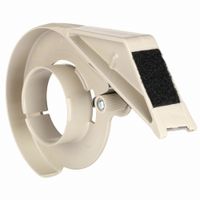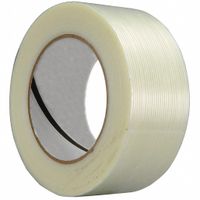Call +(254) 703 030 000 / 751 483 999 / 721 704 777
- Home
- Packaging Shipping
- Packaging Tapes Dispensers Machines
- Strapping Tapes Dispensers
.....Read More
Frequently Asked Questions
What is strapping tape used for?
Strapping tape, also known as filament tape, is a highly durable adhesive tape reinforced with filaments, typically made of fiberglass or polyester, which provide added strength and resistance to tearing. It is primarily used for securing and bundling items, offering a reliable solution for various packaging and shipping needs.
One of the main applications of strapping tape is in the packaging industry, where it is used to reinforce boxes and cartons, ensuring they remain sealed during transit. Its high tensile strength makes it ideal for bundling heavy items, such as pipes, lumber, or metal rods, preventing them from shifting or separating during transportation.
Strapping tape is also employed in palletizing, where it helps secure loads on pallets, maintaining stability and preventing movement. This is particularly useful in warehouses and distribution centers, where efficient handling and storage of goods are crucial.
In addition to industrial uses, strapping tape is often utilized in moving and storage scenarios. It can be used to secure furniture, appliances, and other large items, protecting them from damage during relocation. Its strong adhesive properties ensure that it adheres well to various surfaces, including cardboard, plastic, and metal.
Furthermore, strapping tape is used in the construction and manufacturing sectors for temporary holding and bundling of materials. It can also serve as a reinforcement for weak or damaged areas, providing additional support and stability.
Overall, strapping tape is a versatile and essential tool in various industries, valued for its strength, durability, and reliability in securing and bundling items.
How does a tape dispenser work?
A tape dispenser is a device designed to hold a roll of tape and facilitate its easy dispensing and cutting. It typically consists of several key components: a base, a spindle or core holder, a cutting edge, and sometimes a pressure roller.
The base of the tape dispenser provides stability, allowing the user to pull the tape with one hand while the dispenser remains stationary. This base is often weighted to prevent the dispenser from moving during use.
The spindle or core holder is a cylindrical component that holds the roll of tape in place. It is designed to fit the inner core of the tape roll, allowing it to rotate smoothly as tape is pulled. Some dispensers have adjustable spindles to accommodate different tape sizes.
The cutting edge is usually a serrated blade made of metal or durable plastic. It is positioned at the front of the dispenser. When the user pulls the tape to the desired length, they can press the tape against this cutting edge to sever it cleanly. The serrated design ensures a straight cut and prevents the tape from tearing unevenly.
In some tape dispensers, especially those used for packaging, a pressure roller is included. This roller helps apply the tape smoothly onto a surface, ensuring it adheres properly without wrinkles or bubbles.
To use a tape dispenser, the user pulls the tape from the roll, positions it over the cutting edge, and applies downward pressure to cut the tape. The design of the dispenser allows for quick and efficient tape application, making it a valuable tool in both office and industrial settings.
What are the benefits of using fiberglass-reinforced strapping tape?
Fiberglass-reinforced strapping tape offers several benefits, making it a preferred choice for various applications. Its primary advantage is its exceptional tensile strength, which is significantly higher than that of standard tapes. This strength is due to the embedded fiberglass filaments, allowing it to secure heavy loads effectively without breaking. This makes it ideal for bundling and palletizing in industrial settings.
Another benefit is its resistance to tearing and abrasion. The fiberglass reinforcement provides durability, ensuring the tape remains intact even under rough handling or during transportation. This durability extends the tape's lifespan and reliability, reducing the need for frequent replacements and thus saving costs.
Fiberglass-reinforced strapping tape also offers excellent adhesion properties. It sticks well to a variety of surfaces, including cardboard, plastic, and metal, ensuring that packages remain securely sealed. This strong adhesion is crucial for maintaining the integrity of shipments, especially during long-distance transport.
Additionally, the tape is resistant to temperature fluctuations and moisture, making it suitable for use in diverse environmental conditions. This resistance ensures that the tape maintains its performance in both hot and cold climates, as well as in humid or wet conditions, without losing its adhesive properties or structural integrity.
The tape's versatility is another significant benefit. It can be used in various industries, including shipping, construction, and manufacturing, for tasks such as reinforcing packages, securing loads, and even in some structural applications. Its ability to conform to irregular shapes and surfaces further enhances its utility.
Overall, fiberglass-reinforced strapping tape provides a combination of strength, durability, and versatility, making it an efficient and cost-effective solution for securing and bundling applications across multiple industries.
How do you load a tape dispenser?
1. **Gather Materials**: Ensure you have the tape dispenser and a compatible roll of tape.
2. **Prepare the Dispenser**: Place the dispenser on a stable surface. If it has a cover or protective casing, remove it to access the spindle.
3. **Remove Old Tape (if necessary)**: If there is an old roll, remove it by lifting it off the spindle.
4. **Identify Tape Roll Orientation**: Check the tape roll to determine the direction the tape should unwind. Typically, the sticky side should face down when pulled.
5. **Insert the Tape Roll**: Slide the new tape roll onto the spindle. Ensure the roll is positioned so that the tape unwinds in the correct direction, usually over the top of the roll.
6. **Thread the Tape**: Pull the tape end and thread it through the guide or slot, if the dispenser has one. Ensure the tape is aligned properly to avoid tangling.
7. **Secure the Tape**: Pull the tape end over the cutting blade or serrated edge of the dispenser. Leave a small amount of tape hanging over the edge for easy access.
8. **Test the Dispenser**: Gently pull the tape to ensure it unwinds smoothly and cuts cleanly. Adjust the roll or tape alignment if necessary.
9. **Replace the Cover**: If the dispenser has a cover, replace it to protect the tape and maintain the dispenser’s functionality.
10. **Store Properly**: Place the loaded dispenser in a convenient location for easy access during use.
Can strapping tape be used for heavy-duty packaging?
Strapping tape can be used for heavy-duty packaging, but its suitability depends on the specific requirements of the task. Strapping tape, also known as filament tape, is reinforced with fiberglass filaments, which provide high tensile strength and resistance to tearing. This makes it ideal for bundling heavy items, reinforcing packages, and securing loads during transit.
For heavy-duty packaging, strapping tape is particularly effective when used to reinforce boxes, ensuring that they remain intact under stress. It can be applied to the seams and edges of boxes to prevent them from bursting open. Additionally, strapping tape is often used to secure pallets, as it can hold large and heavy items together, reducing the risk of shifting during transportation.
However, while strapping tape is strong, it may not be suitable for all heavy-duty applications. For extremely heavy or valuable items, additional packaging materials such as stretch wrap, shrink wrap, or metal/plastic strapping might be necessary to provide extra security. The adhesive quality of the tape is also a consideration; it must adhere well to the surfaces being secured, which can be a challenge with certain materials or in extreme temperatures.
In summary, strapping tape is a versatile and strong option for many heavy-duty packaging needs, but its effectiveness will depend on the specific circumstances, including the weight and nature of the items being packaged, as well as environmental conditions. For optimal results, it should be used in conjunction with other packaging materials and techniques tailored to the specific requirements of the shipment.
What is the tensile strength of strapping tape?
The tensile strength of strapping tape varies depending on the material and design of the tape. Common materials used for strapping tape include polypropylene, polyester, and steel, each offering different tensile strengths.
1. **Polypropylene Strapping Tape**: This is a lightweight and economical option, often used for light to medium-duty applications. The tensile strength typically ranges from 300 to 600 pounds per square inch (psi).
2. **Polyester Strapping Tape**: Known for its superior strength and elongation properties, polyester strapping is suitable for medium to heavy-duty applications. Its tensile strength generally ranges from 600 to 1,600 psi, making it a popular choice for securing heavy loads.
3. **Steel Strapping Tape**: This is the strongest type of strapping tape, used for the heaviest loads and most demanding applications. Steel strapping can have a tensile strength ranging from 1,000 to over 5,000 psi, depending on the gauge and width of the steel used.
The choice of strapping tape depends on the specific requirements of the application, including the weight and nature of the load, environmental conditions, and cost considerations.
How do you prevent tape from sticking to itself during application?
To prevent tape from sticking to itself during application, follow these steps:
1. **Choose the Right Tape**: Select a tape with a non-stick or easy-release backing if available. Some tapes are designed to minimize self-adhesion.
2. **Proper Storage**: Store tape in a cool, dry place to prevent the adhesive from becoming too tacky. Keep it in its original packaging until use.
3. **Use a Dispenser**: Utilize a tape dispenser to control the tape's release and application. This helps in maintaining tension and alignment, reducing the chance of the tape folding back on itself.
4. **Clean Hands and Surface**: Ensure your hands and the surface where the tape will be applied are clean and dry. Oils and moisture can cause the tape to stick prematurely.
5. **Cut with Scissors**: Instead of tearing the tape, use scissors to cut it cleanly. This prevents jagged edges that can easily fold and stick to themselves.
6. **Apply Slowly**: Unroll and apply the tape slowly and steadily. This allows you to guide the tape accurately and prevent it from twisting or folding.
7. **Use a Backing**: If possible, keep the backing on the tape until the last moment before application. This is especially useful for double-sided tapes.
8. **Tension Control**: Maintain consistent tension while unrolling the tape. Too much slack can cause the tape to curl and stick to itself.
9. **Avoid Overlapping**: When applying multiple strips, ensure they do not overlap unless intended. Overlapping can cause the tape to stick to itself rather than the intended surface.
10. **Practice**: With practice, you can develop a technique that minimizes self-adhesion, such as using your fingers to guide the tape's path.
By following these steps, you can effectively prevent tape from sticking to itself during application.

